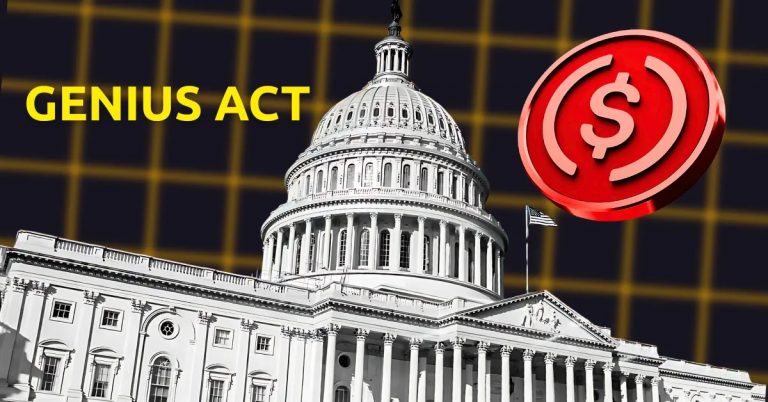Why Are Visa and Mastercard Shares Down After the Passing of the Stablecoin Bill (GENIUS Act) in the USA?
Why Are Visa and Mastercard Shares Down After the Passing of the Stablecoin Bill in the USA? Read the Full Story
Introduction
In a surprising turn of events, the shares of two of the world’s leading payment giants, Visa and Mastercard, dropped by 5% on June 19, 2025, following the recent passing of the U.S. Stablecoin Bill known as GENIUS i.e. “Guiding and Establishing National Innovation for U.S. Stablecoins Act”. This legislative move has sent shockwaves through the financial markets, raising questions about the future of traditional payment systems in the face of rising cryptocurrency adoption. In this detailed article, we explore the reasons behind this decline, the impact of the Stablecoin Bill, and what it means for the financial industry. Read on to uncover the full story!
What Is the U.S. Stablecoin Bill?
Understanding the Implications of the Stablecoin Bill for Financial Markets
The U.S. Stablecoin Bill is a landmark piece of legislation aimed at regulating stablecoins—cryptocurrencies pegged to stable assets like the U.S. dollar, gold, or other fiat currencies. Introduced to provide a legal framework for these digital assets, the bill seeks to enhance consumer protection, prevent money laundering, and ensure financial stability. Stablecoins, such as Tether (USDT) and USD Coin (USDC), have gained significant traction due to their ability to offer fast, low-cost transactions compared to traditional banking systems.
The bill’s passage marks a significant step toward integrating cryptocurrencies into the mainstream financial ecosystem, which has direct implications for traditional payment processors like Visa and Mastercard.
The 5% Drop in Visa and Mastercard Shares: What Happened?
On June 19, 2025, at 11:42 AM IST, financial markets witnessed a notable decline in the stock prices of Visa and Mastercard. This drop coincided with the official enactment of the Stablecoin Bill, sparking widespread speculation. The sentiment on social media suggests that the bill could accelerate the adoption of decentralized finance (DeFi), potentially eroding the dominance of Visa and Mastercard.
Key Reasons Behind the Share Drop
- Rising Adoption of Stablecoins
Stablecoins have seen explosive growth in recent years. According to Visa’s own stablecoin tracker, the transaction volume of stablecoins surged from $560 billion in 2020 to $5.7 trillion in 2024. A report by Fireblocks highlighted that stablecoin payment volume rose from 5% to over 20% of total transactions in 2024 alone. This rapid increase indicates a shift toward decentralized payment systems, which could reduce reliance on traditional card networks.
- Competitive Threat to Traditional Finance
The Stablecoin Bill legitimizes and regulates these digital assets, making them more accessible to businesses and consumers. Stablecoins offer advantages such as lower transaction fees and faster cross-border payments, areas where Visa and Mastercard have historically held a competitive edge. Peer-reviewed studies, such as those published in the Journal of Financial Economics (2023), emphasize that stablecoins could disrupt the $30 trillion global payment industry, putting pressure on legacy players.
- Regulatory Support for DeFi
By providing a clear regulatory framework, the U.S. Stablecoin Bill encourages innovation in decentralized finance. This could lead to the development of alternative payment solutions that bypass traditional intermediaries like Visa and Mastercard. The bill’s focus on consumer protection and financial inclusion aligns with the ethos of cryptocurrencies, further amplifying their appeal.
- Market Sentiment and Investor Concerns
The 5% drop in shares reflects investor concerns about the long-term viability of traditional payment systems. Social media reactions, including posts on X, suggest a growing narrative of “evolve or perish” for financial institutions. Investors may be reallocating their portfolios toward cryptocurrency-related stocks or blockchain technology firms, anticipating a shift in market dynamics.
How the Stablecoin Bill Impacts Visa and Mastercard
Adaptation Challenges
Visa and Mastercard have been proactive in exploring cryptocurrency integration, with initiatives like Visa’s cross-border settlement solutions and Mastercard’s crypto card programs. However, the rapid pace of regulatory changes and the potential for stablecoins to dominate payment flows could outpace their adaptation efforts. The bill’s emphasis on compliance and oversight may also increase operational costs for these companies.
Opportunity for Evolution
Despite the challenges, the decline in shares could be a temporary setback. Both companies have the resources and expertise to pivot toward blockchain-based solutions. By leveraging their existing infrastructure, Visa and Mastercard could partner with stablecoin providers or develop their own digital currency offerings, turning a threat into an opportunity.
The Bigger Picture: Crypto Eating Traditional Finance
The drop in Visa and Mastercard shares is symptomatic of a broader trend where cryptocurrencies are challenging the foundations of traditional finance. With a transaction volume of $27.6 trillion in 2024—surpassing the combined volume of Visa and Mastercard transactions, as noted by the World Economic Forum—stablecoins are proving their potential to reshape the financial landscape. This shift is particularly evident in regions like Asia and Europe, where stablecoin usage is highest.
What Lies Ahead for Visa and Mastercard?
The road ahead for Visa and Mastercard will depend on their ability to innovate and adapt. Industry experts suggest that collaboration with stablecoin issuers or investment in blockchain technology could help these companies regain investor confidence. Additionally, the global push for financial inclusion—serving the over 1 billion unbanked individuals—presents an opportunity for payment giants to integrate stablecoin solutions into their ecosystems.
Conclusion
The 5% drop in Visa and Mastercard shares following the passing of the U.S. Stablecoin Bill on June 19, 2025, underscores the growing influence of cryptocurrencies on traditional finance. While the bill poses challenges by legitimizing stablecoins and accelerating DeFi adoption, it also opens doors for innovation. As the financial world navigates this transition, Visa and Mastercard must evolve to remain competitive. Stay tuned for further updates as this story unfolds!




